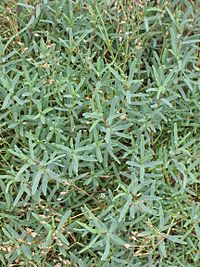Gypsophilia
| Gypsophilia subsp. var. | Baby's-breath, soap wort, Gypsophila | |||||||||||||||||||||||||||||||||||||||||||||||||||||||
|---|---|---|---|---|---|---|---|---|---|---|---|---|---|---|---|---|---|---|---|---|---|---|---|---|---|---|---|---|---|---|---|---|---|---|---|---|---|---|---|---|---|---|---|---|---|---|---|---|---|---|---|---|---|---|---|---|

|
|
| ||||||||||||||||||||||||||||||||||||||||||||||||||||||
| ||||||||||||||||||||||||||||||||||||||||||||||||||||||||
Gypsophila (pronounced /dʒɪpˈsɒfɪlə/)[1]—commonly known as Baby's-breath in the United States and Canada, "soap wort"[citation needed] in the United Kingdom, elsewhere Gypsophila[2]—is a genus of about 100 species of flowering plants in the family Caryophyllaceae, native to Europe, Asia and north Africa. Many species are found on calcium-rich soils, including gypsum, hence the name of the genus. Some species are also sometimes called "baby's breath" or simply, "Gyp", among the floral industry. Its botanical name means "lover of chalk", which is accurate in describing the type of soil in which this plant grows.
They are herbaceous annual and perennial plants growing to 5–120 cm tall. The leaves are opposite, linear to narrow triangular, often falcate (sickle-shaped), 1–7 cm long and 2–8 mm broad. The flowers are produced in large inflorescences, which may be either dense or open and lax; each flower is small, 3–10 mm diameter, with five white or pink petals.
Gypsophilas are often grown as ornamental plants in gardens; they are grown both as garden plants and also valuable as a cut flower in floristry to add as a filler to flower bouquets. The most commonly encountered in gardens are G. paniculata (a perennial species), G. elegans, and G. muralis (both annual species). They are easily propagated from seed, by cuttings, or by root division before growth starts in the spring.
Cultivation
While they prefer full sun, along with rich, light soil, deficiencies in poor soil constitution can be overcome by adding a general purpose fertilizer, as long as it is well drained.
Propagation
Starting as a tiny seed, the annuals and perennials germinate in ten to fifteen days, and can grow rapidly up to 50 cm in height.
Pests and diseases
Varieties
- Selected species
- Gypsophila acutifolia - Sharp-leaved Gypsophila
- Gypsophila altissima
- Gypsophila aretioides
- Gypsophila arrostii
- Gypsophila bicolor
- Gypsophila bungeana - Bunge's Gypsophila
- Gypsophila capituliflora
- Gypsophila cephalotes
- Gypsophila cerastioides
- Gypsophila davurica
- Gypsophila desertorum
- Gypsophila elegans
- Gypsophila fastigiata - Fastigiate Gypsophila
- Gypsophila huashanensis
- Gypsophila licentiana
- Gypsophila muralis - Annual Gypsophila
- Gypsophila nana - Dwarf Gypsophila
- Gypsophila oldhamiana
- Gypsophila pacifica
- Gypsophila paniculata - Common Gypsophila
- Gypsophila patrinii
- Gypsophila perfoliata - Perfoliate Gypsophila
- Gypsophila petraea
- Gypsophila pilosa - Turkish Baby's Breath
- Gypsophila rokejeka - Soap root[3]
- Gypsophila repens - Alpine Gypsophila
- Gypsophila scorzonerifolia - Glandular Gypsophila
- Gypsophila sericea
- Gypsophila spinosa
- Gypsophila tenuifolia
- Gypsophila tschiliensis
Gallery
References
- ↑ Sunset Western Garden Book, 1995:606–607
- ↑ Gypsophila at USDA PLANTS Database
- ↑ Ethnological Museum of Thrace
External links
- w:Gypsophilia. Some of the material on this page may be from Wikipedia, under the Creative Commons license.
- Gypsophilia QR Code (Size 50, 100, 200, 500)
